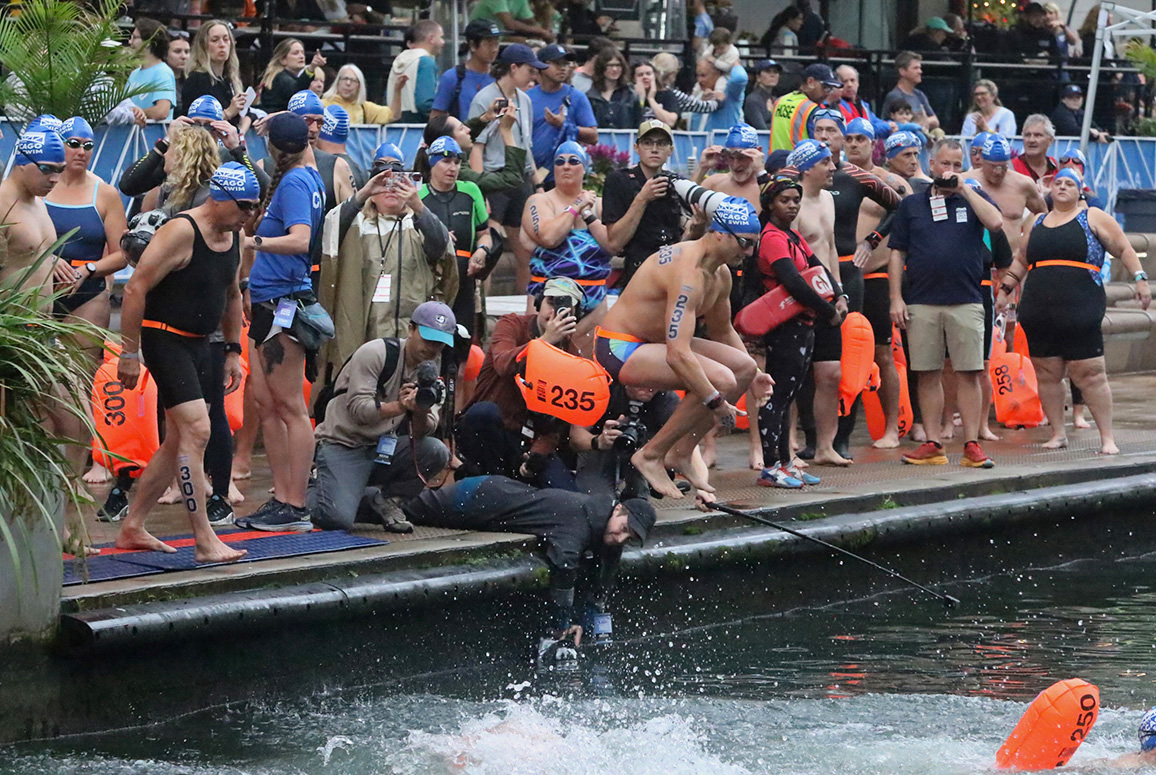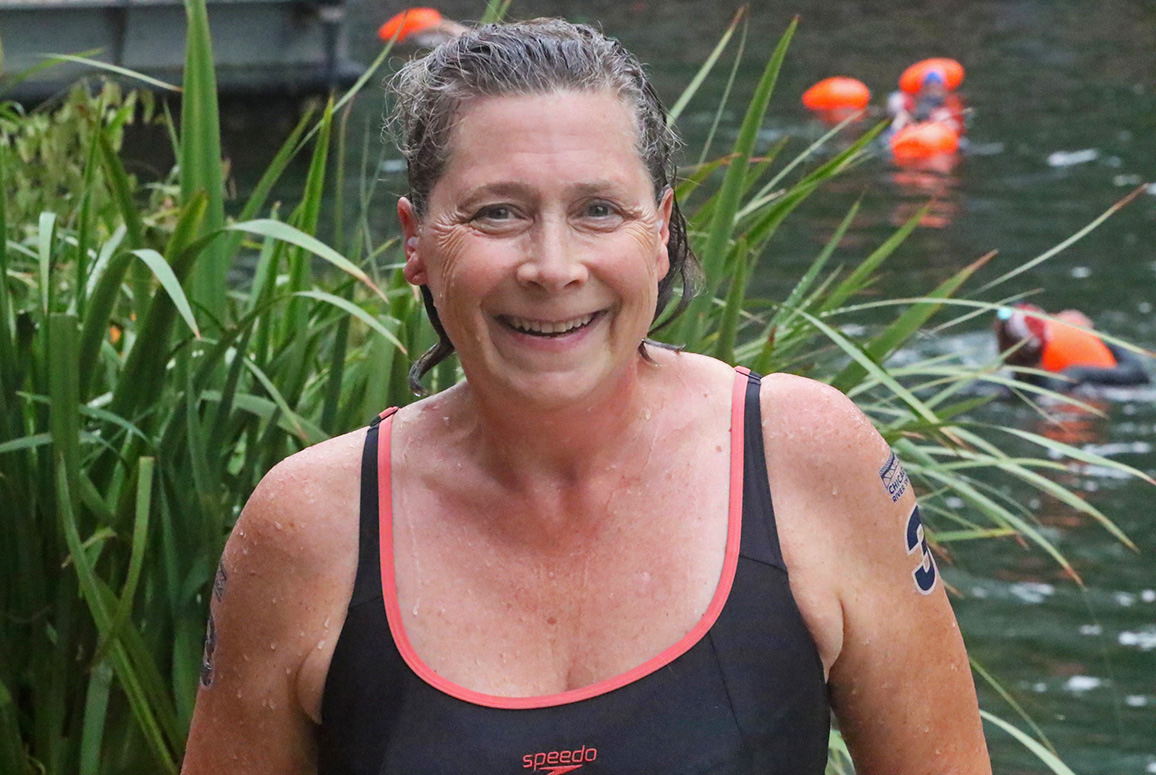
The Chicago River was once so toxic that it went up in flames. On 21 September 2025, after 100 years of being told the river was unswimmable, 263 swimmers took to the water and showed what’s possible for cities around the world.
A few days before the Chicago River Swim, I drove across a bridge spanning the river’s North Branch. Looking down, I saw a sleek animal cutting through the water — a mink, maybe, or an otter – possibly a beaver. These days, all three call the river home, along with eagles, herons, snapping turtles, largemouth bass, channel catfish and more than 80 other species of fish. I didn’t bump into any turtles during the swim, but knowing they are once again part of the river’s ecosystem made me optimistic about what can be achieved – not just here in Chicago but in cities around the world.
People keep asking me what it was like to swim in a river that was once infamous for everything it carried away: raw sewage, industrial runoff, slaughterhouse byproducts, even 800 pounds of human waste from a Dave Matthews Band tour bus. As the river was the object of ridicule for so many decades, it’s hard now for people to grasp that the clean-up is working. In addition to supporting wildlife, the river is used by kayakers, paddle boarders, sailors – and now swimmers. You can board a river cruise. You can fish, jog and bike along the River Walk. You can dine at riverfront restaurants. You can even rent a floating hot tub. The river has transformed – from dumping ground to playground.
I didn’t bump into any turtles during the swim, but knowing they are once again part of the river’s ecosystem made me optimistic about what can be achieved.
 Bob Lee
Bob Lee
The Chicago River’s rebirth is part of a global movement reclaiming rivers for the good of both people and planet. Here in the Windy City, the transformation is largely down to stronger federal and local water quality regulations, massive infrastructure investments, and advocacy and clean-up efforts led by non-profit organisations. Friends of the Chicago River has been pushing for river reform since 1979. In 2023, it became a member of Swimmable Cities, an international grassroots movement dedicated to promoting the Right to Swim and Nature Rights in urban waterways. Cities that have signed the Swimmable Cities Charter include Paris, Rotterdam, Budapest, Melbourne and – stateside – Annapolis, MD, Portland, OR, and Sheboygan, WI.
The last time Chicago held an organised river swim was in 1927 when five-time gold medal Olympian Johnny Weissmuller won. He then went on to star in ‘Tarzan the Ape Man’ movies. This year’s swim is testament to how far the river has come since the days of black-and-white films.
I have logged my share of open-water events, but the Chicago River Swim was something else – less a race; more a moment to reflect on the change we’ve all dreamt of and which is finally taking place.
There were also some nerves. In the lead-up, there had been a light but persistent rain. If it turned into a hard and fast downpour, runoff could overflow into the river, temporarily lowering the water quality and potentially cancelling the race. Any sign of lightning within 12 miles would have also marked the end. This touch-and-go forecast surprised no one given the adage: ‘If you don’t like the weather in Chicago, wait 15 minutes.’ That’s just what happened: the sun rose, the rain petered out, and at 6:15 a.m., showrunner Doug McConnell announced: ‘The race is on!’
The swim started across from the iconic, corn cobb-shaped Marina Towers, just west of the Lake Michigan Harbor lock. (The Chicago River was famously reversed in 1900 so that water flows away from the city to the Mississippi River.) The lock controls water entering the river from Lake Michigan, which is one of North America’s five Great Lakes – so big it’s sometimes called an inland sea.
Swimmers were organised in waves. We lined up on the River Walk, and once up, we jumped in feet first, two swimmers at a time. The water was surprisingly warm – 74F/23C (Lake Michigan rarely gets that toasty), and also very dark. I expected visibility would be poor – that’s why I wore light-colored goggles – but it was a little disconcerting under the first bridge when the water went from dark to black.
The river course was much easier than other lake and sea swims I’ve done: there were no currents or waves, and the river’s steel wall made a great marker to keep everyone on track. I won’t forget swimming below a railroad bridge as the El rumbled overhead or looking up at Chicago’s beautiful glass, steel and granite high-rise buildings from this new perspective. I’m also going to savour the memory of hearing my name echo from loudspeakers as I rounded the mid-point buoy – a nice surprise arranged by my daughter.
After the event, many swimmers described their experiences in glowing terms, using words like amazing, epic, incredibly clean, best-swim ever, all-around fantastic. ‘There wasn’t even a piece of garbage floating in a corner!’ said one. No one has reported getting sick.
I have logged my share of open-water events, but the Chicago River Swim was something else – less a race; more a moment to reflect on the change we’ve all dreamt of and which is finally taking place.
The Chicago River Swim was 13 years in the making. McConnell had hoped the inaugural 21st Century swim would take place last year, but the Chicago Department of Transportation denied the permit eight weeks before race day due to concerns about the route and number of swimmers. As a compromise, the 2024 race was held in Lake Michigan. This year, McConnell secured the permit to swim in the river just six weeks before the event. That journey was nothing compared to his family’s struggle with ALS, a progressive disease that causes muscle movement to deteriorate. Doug’s father fought ALS for 12 years before his death in 2006, only for Doug’s sister Ellen to be diagnosed soon afterwards. She passed away in 2018.
The siblings established A Long Swim in 2011 to raise funding for ALS research at Northwestern University’s Feinberg School of Medicine, choosing to focus on open water events as Doug is a lifelong competitive swimmer. A Long Swim has raised more than $2 million for ALS research through sponsorships and swimmer-led fundraising for races in the Chicago suburbs, as well as sponsorships of distance swims including the English Channel, Catalina Channel, the Ka’iwi Channel, Tampa Bay, Nantucket to Martha’s Vineyard, and Manhattan Island. The Chicago River Swim added $100,000 to that total, plus $50,000 for youth swimming lessons at a West Side community pool.
As event planner, McConnell was too busy to swim with the rest of us, but thanks to his efforts, the race will leave a lasting impact on Chicago and inspire similar changes in other cities across the US.
And there’s always next year: the 2nd Chicago River Swim is scheduled for 20th September 2026.
 Adrienne on race day
Adrienne on race day
Adrienne Fawcett is a lifelong swimmer who swims in Lake Michigan every day, even when it’s covered in ice. She frequently travels to Ireland and the UK for open-water swims in the sea, tidal pools and ponds. Follow her at @fourseasonswimmer